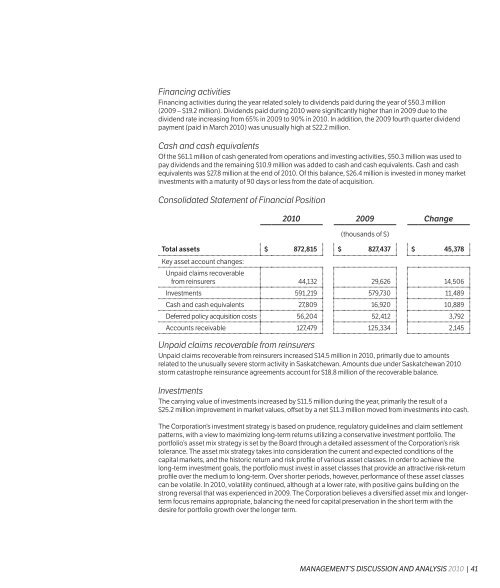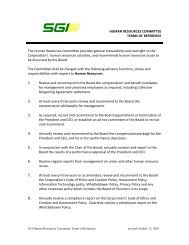Full report - SGI Canada
Full report - SGI Canada
Full report - SGI Canada
You also want an ePaper? Increase the reach of your titles
YUMPU automatically turns print PDFs into web optimized ePapers that Google loves.
13. Financial Risk Management<br />
The nature of the Corporation’s operations result in a statement of financial position that consists primarily<br />
of financial instruments. The risks that arise are credit risk, market risk (consisting of interest rate risk,<br />
foreign exchange risk and equity price risk) and liquidity risk.<br />
Significant financial risks are related to the Corporation’s investments. These financial risks are managed<br />
by having a Statement of Investment Policies and Goals (SIP&G), which is approved annually by the<br />
Corporation’s Board of Directors, based on a recommendation from the Board’s Investment Committee.<br />
The SIP&G provides guidelines to the investment manager for the asset mix of the portfolio, regarding<br />
quality and quantity of debt, real estate and equity investments using a prudent person approach. The<br />
asset mix guidelines help reduce the impact of market value fluctuations by requiring investments in<br />
different asset classes and in domestic and foreign markets. <strong>SGI</strong> receives regular <strong>report</strong>ing from the<br />
investment manager and custodian regarding compliance with the SIP&G.<br />
Credit risk<br />
The Corporation’s credit risk arises primarily from two distinct sources: accounts receivable (from its<br />
customers, brokers and reinsurers) and certain investments. The maximum credit risk to which it is<br />
exposed at December 31, 2010, is limited to the carrying value of the financial assets summarized<br />
as follows:<br />
2010 2009<br />
(thousands of $)<br />
Carrying Value<br />
Carrying Value<br />
Cash and cash equivalents $ 27,809 $ 16,920<br />
Accounts receivable 127,479 125,334<br />
Fixed income investments 1 435,150 435,128<br />
Unpaid claims recoverable from reinsurers 44,132 29,626<br />
1<br />
Includes short-term investments, bonds and debentures and the mortgage pooled fund<br />
In addition, the Corporation is exposed to credit risk associated with its structured settlements and<br />
securities lending program as described separately in the notes to the consolidated financial statements.<br />
Cash and cash equivalents include money market investments of $26,448,000 plus cash on hand, net of<br />
outstanding cheques of $1,361,000 (2009 – money market investments of $22,300,000 less cash on hand,<br />
net of outstanding cheques of $5,380,000). The money market investments mature within 90 days from the<br />
date of acquisition and have a credit rating of R-1.<br />
Accounts receivable are primarily from customers, diversified among residential, farm and commercial,<br />
along with amounts from brokers across the provinces that <strong>SGI</strong> CANADA operates in. Accounts receivable<br />
consist of balances outstanding for one year or less.<br />
2010 2009<br />
(thousands of $)<br />
Current $ 126,194 $ 121,370<br />
30-59 days 594 1,077<br />
60-89 days 253 351<br />
Greater than 90 days 5,551 8,797<br />
Subtotal 132,592 131,595<br />
Allowance for doubtful accounts (5,113) (6,261)<br />
Total $ 127,479 $ 125,334<br />
Provisions for credit losses are maintained in an allowance account and regularly reviewed by the<br />
Corporation. Amounts are written off once reasonable collection efforts have been exhausted. Details of<br />
the allowance account are as follows:<br />
2010 2009<br />
(thousands of $)<br />
Allowance for doubtful accounts, opening balance $ 6,261 $ 4,900<br />
Accounts written off (2,134) (1,430)<br />
Current period provision 986 2,791<br />
Allowance for doubtful accounts, ending balance $ 5,113 $ 6,261<br />
Credit risk within investments is related primarily to short-term investments, bonds and debentures,<br />
and the mortgage pooled fund. It is managed through the investment policy that limits debt instruments<br />
to those of high credit quality (minimum rating for bonds and debentures is BBB and for short-term<br />
investments is R-1), along with limits to the maximum notional amount of exposure with respect to any one issuer.<br />
82 | 2010 NOTES TO THE CONSOLIDATED FINANCIAL STATEMENTS NOTES TO THE CONSOLIDATED FINANCIAL STATEMENTS 2010 | 83















